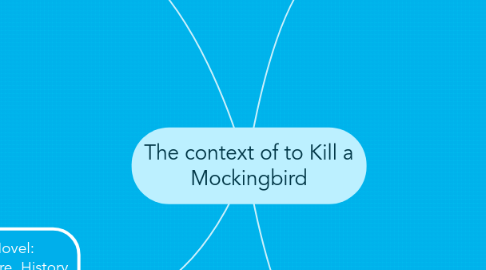
1. The Scottsboro Case
1.1. The Case
1.1.1. On March 25th 1931, several white boys claimed they were attacked by a group of black boys. they were arrested by the sheriff. they found two white girls nearby, who also claimed that the group had attacked them and raped them. soon after there was a trial in Scottsboro, Alabama. The boys were sentenced to death, but the case was appealed and instead recieved 75 years of prison.
1.2. The Influence of the Scottsboro case on Harper Lee’s novel To Kill A Mockingbird:
1.2.1. This trial happened during Harper Lee’s childhood, and there’s a clear connection between her life, the case and the novel.
1.3. Reaction
1.3.1. 1. Looking at the global reaction to the novel? At the the start of To Kill A Mockingbird they sold 500,000 copies. There has been many attempts to ban the teaching of the novel in schools. Some of the reason are because the book is about rape, it is immoral and obscene and uses words such as damn and whore girl. 2. How people reacted to Harper Lee basing a story on a true case? The novel was narrated by a 9 year old girl, which some people believed made the story unrealistic. 3. What critics said about it? the reviews I have read it sounds like it is a top book. They all say it had a slow fuzzy start but it really grew on them and people say how they hate themselves for only reading it after they left school.
2. The setting of the Novel: Alabama - It's Culture, History and People
2.1. The first settlement of Alabama
2.1.1. Mobile was the first settled town in Alabama. It was settled by the French.
2.1.2. This is where Simon Finch built the finch landing
2.2. The History of Alabama
2.2.1. Alabama was one of the old Southern plantation states and because of this many slaves lived and worked on the cotton plantations.d around the county.
2.3. The Relations of People
2.3.1. Most of the slaves working for the plantations were Blacks, which as a result, let the White people think they were in a higher position than the Blacks. This lead to the problem of racism, and lead to some incidents like the Tom Robinson case in the book, the Blacks didn't share the same right with the Whites.
3. The Life of Harper Lee
3.1. Early Life (Childhood)
3.1.1. April 28, 1926, Monroeville, Alabama.
3.1.2. Youngest of 4 Childern
3.1.3. Mother suffered from a mental illness and rarely left the house Father was a professional lawyer
3.1.4. Truman Capote neighbour and lifelong friend (features as Dill in TKAM)
3.2. Aspiring Adult - Lee's struggle for success
3.2.1. Transferred to Uni of Alabama, then Oxford Uni
3.2.2. While in New York she reunited with old childhood friend Truman Capote and good friends with Martin Brown, a broadway composer and lyricist. As a birthday present he kindly decided to support her financially for one year so she could begin writing TKAM.
3.3. To Kill a Mockingbird
3.3.1. Her first and only published novel was in 1960.
3.3.2. To Kill a Mockingbird was Lee’s one and only literary successes; her only novel to be published, and is the reason for her fame, it won her the Pulitzer Prize in 1961
3.3.3. Many of the characters were based on people in Lee's childhood, Scout was a reflection of herself, Atticus of her father, Dill of her childhood best friend Truman Capote and Boo Radley of a neighbour
3.4. Adult Life, Post Mocking Bird
3.4.1. After Completing To Kill a Mockingbird, Harper Lee accompanied her close friend Truman Capote in collecting information and researching the murder of a Farmer and his Family. Truman Capote then continued with this information and produced his best-selling book, In Cold Blood.
3.4.2. Harper Lee then carried on helping with the production of To Kill a Mockingbird movie which was released in 1962.
4. Civil Rights Movement
4.1. What was the Civil Rights Movement?
4.1.1. The Civil Rights Movement was a series of worldwide political movements that aimed for equality for all. It mainly was aimed to aid women, racil minoroities and LGBT community.
4.1.2. The African-American Civil Rights Movement were a series of social movements that aimed to outlaw racial discrimination against black Americans and to give them equal rights.
4.1.3. occurred in1955 to 1968, particularly in the South
4.2. What was the Civil Rights Movement?
4.2.1. Define actions as necessary
